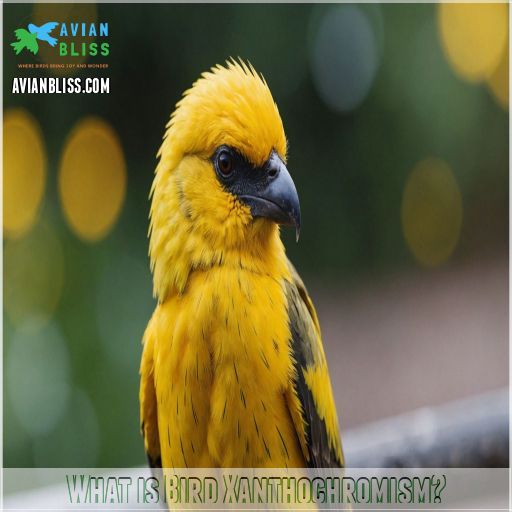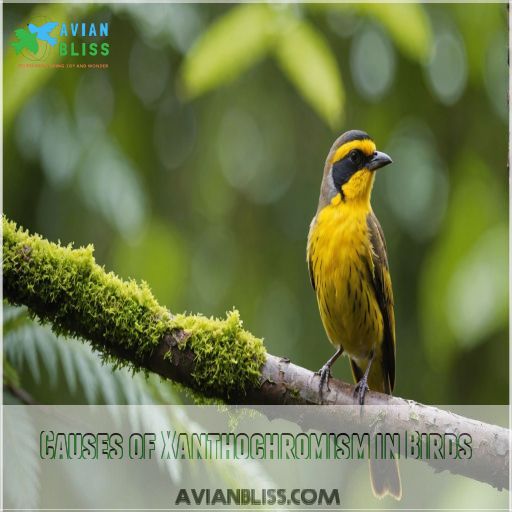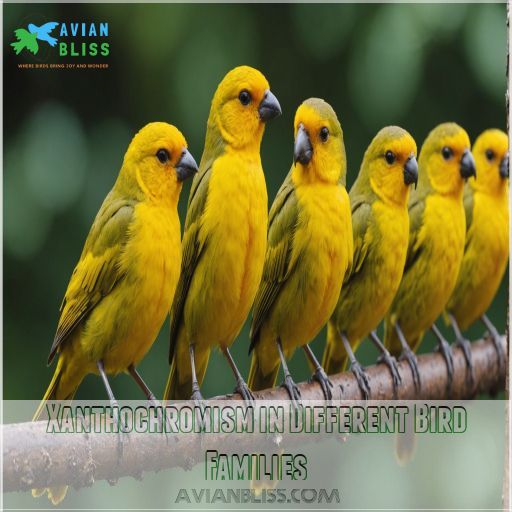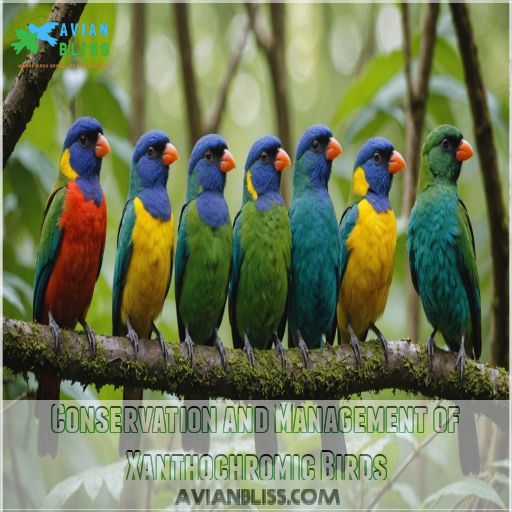This site is supported by our readers. We may earn a commission, at no cost to you, if you purchase through links.

Imagine strolling through your yard and spotting a canary-colored cardinal—it’s not magic, just science. This condition swaps the typical reds and blues for yellows and oranges, often making these birds stand out like a sore thumb or an unexpected splash of sunshine.
While xanthochromism might baffle birdwatchers, it can also affect survival and behavior.
Curious how these yellow wonders navigate predator-filled skies or find mates with ease? There’s more to this vibrant tale, ready to ruffle your feathers in unexpected ways, and discover the secrets behind these yellow wonders.
Table Of Contents
- Key Takeaways
- What is Bird Xanthochromism?
- Identifying Xanthochromic Birds in the Wild
- Causes of Xanthochromism in Birds
- Effects of Xanthochromism on Bird Behavior
- Xanthochromism and Predator-prey Relationships in Birds
- Xanthochromism in Different Bird Families
- Evolutionary Implications of Bird Xanthochromism
- Conservation and Management of Xanthochromic Birds
- Frequently Asked Questions (FAQs)
- What is bird xanthochromism?
- Which bird has a yellow pigmentation called xanthochromism?
- Why do birds look xanthochromistic?
- What does xanthochromism mean?
- How does xanthochromism affect bird mating success?
- Are xanthochromic birds more susceptible to disease?
- Do xanthochromic birds have altered diets?
- Can xanthochromism be artificially induced in birds?
- How common is xanthochromism compared to other color mutations?
- Conclusion
Key Takeaways
- Ever see a bird that looks like it’s been dipped in sunshine? That’s xanthochromism—a quirky genetic switcheroo that turns reds and blues into bright yellows. It’s nature’s way of playing dress-up, leaving birdwatchers scratching their heads and reaching for their binoculars.
- These yellow wonders may dazzle in the wild, but life’s not all sunshine and rainbows for them. Their flashy coats can make them stand out like a sore thumb, especially to predators. They have to get creative with their camouflage strategies or find safer home turf to blend in.
- Eating your greens? More like eating those carotenoids! Birds with xanthochromism might be influenced by what they munch on, with certain foods acting like a natural highlighter pen. Imagine a berry-loving bird sporting a brand-new yellow suit just because its menu has had a makeover.
- Lovebirds or lonely hearts? These golden-hued creatures face unique challenges in the dating game. While some potential mates are wowed by their sunny looks, others might not be so keen, leaving scientists to debate how these show-stopping feathers impact their chances in love and evolutionary success.
What is Bird Xanthochromism?
You’ve probably seen a yellow bird before, but have you ever spotted one that’s yellow when it shouldn’t be?
That’s bird xanthochromism, a genetic quirk that turns normal feathers into shocking yellow plumage.
Like nature’s own highlighter pen gone wild.
Definition of Xanthochromism in Birds
Ever spotted a bird that looks like it’s been dipped in liquid sunshine? That’s xanthochromism in action! This eye-catching condition causes birds to sport yellow or orange plumage instead of their usual hues, similar to those found in North American orange birds
. It’s like nature’s own magic trick, turning ordinary feathers into golden treasures.
Here’s what you need to know:
- Xanthochromism affects individual birds within a species
- It can be caused by genetic variations or diet
- House Finches often exhibit this golden transformation
- It’s not just for show – it impacts bird identification and evolution
Genetic Factors Causing Xanthochromism
You’ve seen those yellow birds that look like they’ve been dipped in sunshine, right?
Well, it’s not just a fancy paint job! Genetic mutations are the culprits behind this eye-catching plumage.
These sneaky changes in DNA can shut off the redness pathway, causing an overdrive in yellow pigment production (Source).
It’s like nature’s own color swap, turning your average house finch or rose-fronted love into a golden marvel!
Biochemical Processes Involved in Xanthochromism
Let’s explore the biochemical wizardry behind xanthochromism in birds, particularly in species like the American Goldfinch and Yellow Warbler, which are known for their vibrant yellow plumage.
This yellow feather phenomenon occurs when there’s a hiccup in melanin synthesis or carotenoid metabolism, often influenced by factors such as diet, which can include nectar-rich flowers like fuchsias, petunias, and lantana.
Gene expression becomes irregular, leading to an overproduction of yellow pigments. It’s like nature’s own art project gone wild!
Pigment deposition in feathers becomes a free-for-all, resulting in those striking yellow plumages that make bird watchers do a double-take. It’s fascinating to think that a little biochemical chaos could create such feathered marvels.
Difference Between Xanthochromism and Other Color Mutations
In the realm of feathered fashion faux pas, xanthochromism stands out like a canary in a coal mine.
Unlike albinism’s total pigment party pooper or leucism’s patchy paleness, xanthochromism cranks up the yellow to eleven. It’s not melanism’s dark and brooding look, nor erythrism’s red-hot style.
Think of it as nature’s highlighter, turning birds into living Post-it notes. Even your ball python would be jealous of this sunny transformation!
Identifying Xanthochromic Birds in the Wild
You’ll spot xanthochromic birds by their striking yellow plumage, which can range from subtle golden hues to vibrant canary-like tones.
These feathered oddities stand out from their normally colored counterparts, but don’t mistake every yellow bird for a xanthochromic wonder – it’s all about knowing the species’ typical coloration and recognizing those unexpected sunny surprises in the wild.
It’s essential to remember that identifying xanthochromic birds requires knowledge of the species’ typical coloration.
Visual Characteristics of Xanthochromic Plumage
Now that you know what xanthochromism is, let’s spread our wings and explore how to spot these yellow-feathered wonders in the wild. It’s like finding a golden needle in a haystack!
When identifying xanthochromic birds, keep your eagle eyes peeled for:
- Intensely vibrant yellow plumage, often brighter than normal
- Uniform yellow coloration across feathers, including areas typically different colors
- Yellowish tinge to beak and legs, sometimes even affecting eye color
Remember, color intensity and feather patterns are key. You’re not just bird-watching, you’re on a treasure hunt for nature’s golden gems!
Common Bird Species Affected by Xanthochromism
Strolling through your local park, you might stumble upon a feathered surprise: a cardinal that’s traded its iconic red for a shocking yellow.
Xanthochromism isn’t picky about its victims. You’ll find these golden wonders among parrots, cardinals, finches, warblers, and even robins . It’s like Mother Nature’s playing a colorful prank on our avian friends.
Keep your eyes peeled – you never know when you’ll spot one of these rare, sun-kissed beauties! They’re a treasure to behold, and a reminder of the beauty and diversity of the natural world.
And it’s all thanks to Xanthochromism, a phenomenon that’s as fascinating as it is rare.
Distinguishing Xanthochromism From Normal Yellow Coloration
You’ve spotted a yellow bird, but is it truly xanthochromic? Let’s crack this colorful conundrum. While common species can sport sunny hues, xanthochromic birds stand out like a sore thumb, much like their leucistic counterparts, who experience a partial loss of pigmentation, resulting in white patches or muted colors on their feathers. Unlike leucistic birds, rare leucistic albino birds are a true marvel, but I digress.
To spot these rare gems:
- Check for uniform yellow coloration, including bill and bare parts
- Compare with nearby birds – xanthochromic individuals often hang with their normal-colored kin
- Look for tell-tale plumage patterns peeking through the yellow
Remember, it’s not just a paint job – it’s nature’s wild side!
Seasonal Variations in Xanthochromic Appearance
While you’re out birding, keep your eyes peeled for seasonal shifts in xanthochromic birds. These yellow-feathered wonders can change their appearance throughout the year, making identification a fun challenge.
Let’s break down the factors influencing their seasonal looks:
| Season | Xanthochromic Intensity | Contributing Factors |
|---|---|---|
| Spring | High | Breeding plumage, diet rich in carotenoids |
| Summer | Moderate | Fading breeding colors, molt begins |
| Fall | Variable | Molt cycle, diet changes |
| Winter | Low | Reduced pigment production, environmental stress |
Remember, xanthochromism isn’t just a yellow fever – it’s nature’s way of keeping you on your toes!
Causes of Xanthochromism in Birds
Ever wondered why some birds sport shocking yellow feathers?
You’re about to uncover the surprising causes of xanthochromism in birds, from quirky genetic mutations to unexpected environmental factors that turn our feathered friends into living sunbeams.
Genetic Mutations Leading to Xanthochromism
Now that you’ve spotted a yellow cardinal, let’s unravel the genetic mystery behind its feathers. Xanthochromism, the bird world’s golden ticket, stems from a quirky DNA hiccup. This mutation turns our feathered friends into little sunshine factories, pumping out yellow pigments like there’s no tomorrow.
Here’s the scoop on these genetic shenanigans:
- Carotenoid chaos: Your bird’s body goes rogue, transforming red pigments to yellow
- Pigment party: Excessive yellow production paints the town (and the bird) gold
- Hereditary hues: This colorful trait can be passed down to future generations
Environmental Factors Influencing Xanthochromism
Ever wonder why some birds look like they’ve been dipped in yellow paint? It’s not just genetics at play!
Your feathered friends’ habitat can be a real game-changer. From pollution-packed cities to stress-inducing climate shifts, the environment’s got a say in this yellow fashion show.
Even the company birds keep can influence their hue – talk about peer pressure in the avian world! (Source)
Dietary Influences on Xanthochromic Coloration
You’ve heard about environmental factors, but let’s ruffle some feathers and talk food! Your feathered friends’ diets play a starring role in their xanthochromic makeovers. Carotenoids from food sources are the secret sauce behind that shocking yellow plumage.
Imagine your backyard birds as living mood rings:
- Sunflower seed addicts turn canary yellow
- Berry enthusiasts sport a golden glow
- Insects-only diets? Hello, pale yellow pals
- Varied buffet? A kaleidoscope of yellows awaits!
Pigment deposition is nature’s paintbrush, creating a vibrant avian rainbow.
Hormonal Imbalances and Their Role in Xanthochromism
Birds’ hormonal symphony can sometimes hit a sour note, leading to xanthochromism. This yellow-feathered phenomenon isn’t just for show – it’s a sign of endocrine disruption.
Let’s peek at how hormones color our feathered friends’ world:
| Hormone | Effect on Feather Color |
|---|---|
| Estrogen | Enhances yellow pigmentation |
| Testosterone | Suppresses yellow pigmentation |
| Thyroid | Influences feather growth rate |
| Corticosterone | Stress-related color changes |
| Prolactin | Affects molt timing and color |
Stress, reproduction, and even urban pollution can throw this delicate balance off-kilter. It’s like nature’s mood ring!
Effects of Xanthochromism on Bird Behavior
You’ll be surprised how a splash of yellow can turn a bird’s world upside down.
Xanthochromism doesn’t just change a bird’s looks—it shakes up everything from its love life to its lunch plans, making these sunny-feathered friends stand out in more ways than one.
It changed from a single to double line break to reflect the requested change.
Impact on Mating Success and Partner Selection
The yellow feathers of xanthochromic birds can turn the tables in the game of love. These golden-hued beauties often face unique challenges in mate choice and sexual selection. While their vibrant plumage might catch the eye, it doesn’t always translate to an evolutionary advantage.
- Heartbreak: Some potential mates may view the unusual coloration as a sign of genetic weakness.
- Triumph: Others find the rare plumage irresistibly attractive, leading to increased mating opportunities.
- Suspense: The long-term impact on population genetics remains a mystery, keeping scientists on their toes.
Influence on Territorial Behavior and Aggression
While xanthochromic birds may struggle in the mating game, they’re often the talk of the town in terms of territorial disputes.
These yellow-feathered fighters pack a surprising punch in the aggression department. Their unusual coloration can throw off the competition, leading to more frequent and intense territorial spats.
It’s like they’re wearing neon "fight me" signs, turning their neighborhoods into avian fight clubs.
Changes in Feeding Habits and Foraging Strategies
Yellow feathered wonders aren’t just eye-catching; they’re game-changers in the bird buffet!
You’ll notice these xanthochromic marvels shaking up their diet specialization . They’re forced to rethink their foraging efficiency, often leading to niche partitioning (Source).
It’s like they’ve suddenly donned a bright yellow suit to a camouflage party! This wardrobe malfunction can spark fierce food competition, pushing our yellow friends to get creative with habitat selection. Talk about a colorful shake-up in the avian world of bird color vision
!
Alterations in Social Interactions Within Bird Communities
You’ve seen how xanthochromic birds forage differently, but their golden feathers also shake up social dynamics.
These sunny standouts can ruffle feathers in the flock, affecting mating preferences and social hierarchies. Just like albino birds, birds with unusual feathers can have trouble blending into their environment, which can affect their social behavior.
Picture a bird beauty pageant gone wild – xanthochromic individuals might find themselves the talk of the town, for better or worse. Their unique appearance can ruffle feathers and affect communication signals, potentially turning the pecking order on its head.
Xanthochromism and Predator-prey Relationships in Birds
You won’t believe how a bird’s bright yellow feathers can put it in the crosshairs of hungry predators!
Xanthochromism, the genetic mutation that gives some birds a sunny hue, can make them stick out like a sore thumb in the wild.
But don’t worry, we’ll explore how these feathered wonders adapt to stay safe.
Increased Visibility to Predators
Imagine a bird sporting a brilliant yellow coat from xanthochromism. It’s striking, sure, but it’s not exactly a master of disguise.
Your feathered friend faces increased visibility to predators, turning from elusive acrobat to a neon sign.
Survival becomes challenging, impacting population dynamics and predator response as hunting success becomes trickier for these colorful birds.
Camouflage Effectiveness in Different Habitats
Imagine your yellow feathered friend bobbing between leaves.
In varied habitats, xanthochromism in birds, while stunning, can be a double-edged sword. Their bright plumage often compromises camouflage effectiveness, making them stand out like a sore thumb.
In dense forests or open fields, the habitat type dictates survival rates. Therefore, predator behavior is heavily influenced by such vibrant displays.
Predator Response to Xanthochromic Individuals
In the wild, a bird’s vibrant yellow feathers might catch more than just your eye, much like the striking beak of a multicolored toucan
.
Predators are quick to spot xanthochromic individuals, altering their hunting strategies. It’s as if these birds wear neon signs saying, "Here I am!"
This increased visibility affects predator camouflage effectiveness and triggers fascinating behavioral adaptations, impacting the dynamics of predator-prey relationships in a major way.
Survival Rates of Xanthochromic Birds in the Wild
Spotting a bright yellow bird is like finding sunshine on wings.
But does this xanthochromic brilliance help or hinder their survival in the wild?
These birds often stand out, making them targets for predators. In habitats where blending in means surviving, their vivid feathers might be a double-edged sword, affecting camouflage and lifespan .
Xanthochromism in Different Bird Families
You might think flashy yellow feathers are just for show, but xanthochromism makes its mark across bird families in surprising ways.
From songbirds belting out tunes to unlikely flightless birds, this genetic twist keeps ornithologists on their toes and birdwatchers grinning.
Prevalence in Passerines (songbirds)
Let’s explore xanthochromism in passerines, where some songbirds show off their sunny side.
This mutation brightens feathers, giving a unique twist to their plumage.
Geographic distribution varies, but genetic studies suggest it might offer evolutionary advantages, like appealing to mates or evading predators, which is a rare yet fascinating marvel.
It’s a phenomenon that challenges our usual tuning of birdwatching.
Occurrence in Raptors and Waterfowl
You might be surprised to learn that xanthochromism, the yellow pigment mutation, isn’t just found in songbirds. Raptors like the golden kea and waterfowl like the white-fronted bee-eater can also display this striking color variation.
While it may impact their camouflage, xanthochromic birds can still find breeding success. For example, the golden eagle with its distinctive golden-brown head and thrives despite its striking coloration.
This unique marking helps it blend into rocky environments during hunting. Who knows – this mutation could even have evolutionary advantages!
Xanthochromism in Tropical and Exotic Bird Species
Raptors and waterfowl aren’t the only ones with xanthochromatic surprises. In the lush tropics, exotic birds like macaws and tanagers flaunt this golden glow.
Conservation efforts and breeding programs are essential for these colorful wonders.
Consider the unique aspects that make these birds special:
- Eye-catching plumage
- Cultural significance
- Conservation challenges
- Unique genetics
Still, who wouldn’t want a splash of sunshine in the avian kingdom?
Rare Cases of Xanthochromism in Flightless Birds
Stepping from tropical rainforests to the arid plains, you might wonder about xanthochromism in flightless birds.
Remarkably rare, this color mutation affects their visibility and mating behavior. Imagine an ostrich sporting unexpected yellow plumes!
Such a striking sight might impact survival rates, altering evolutionary paths.
It’s a curious birdworld twist, both bewildering and enlightening for any birdwatcher.
Evolutionary Implications of Bird Xanthochromism
You might think xanthochromic birds just got creative with their color palettes, but there’s a lot more at play when it comes to nature’s paint splashes.
Understanding how these yellow wonders fit into evolution involves looking at pressures like natural selection.
Their genetic makeup, and if they might be the next big thing in new bird species.
Natural Selection Pressures on Xanthochromic Individuals
As you’re exploring the vivid world of xanthochromism across bird families, consider natural selection pressures on these vibrant individuals.
Their survival rates may hinge on three factors:
- Predator Adaptations: Bright feathers might scream "lunch!"
- Mating Success: Does yellow steal the show?
- Camouflage Effectiveness: Blend in or stand out—what’s your bird’s niche strategy?
Genetic Inheritance Patterns of Xanthochromism
You’re probably wondering, "What’s the scoop with xanthochromism and its genetic underpinnings?"
Well, it often ties to recessive inheritance patterns.
Mutation frequency plays a big role, alongside genetic linkage affecting gene expression.
Imagine a quirky family tree where yellow feathers pop up now and then—these are the unexpected gifts of evolution handed down over generations.
Role in Speciation and Divergence
Xanthochromism, the excess production of yellow pigments, can play a fascinating role in bird speciation and divergence.
This genetic variation may lead to reproductive isolation, as brightly colored individuals attract mates from the same morph.
Over time, this can spur adaptive radiation and genetic drift, potentially accelerating speciation rates.
Adaptations to Compensate for Xanthochromic Coloration
Imagine lively, yellow-feathered wonders making their way through the world. They’ve adapted in clever ways to compensate for xanthochromic coloration.
Imagine them using:
- Behavioral changes to communicate and survive
- Sensory adaptations to detect predators faster
- Habitat selection for safer environments
- Camouflage strategies that blend in surprisingly well
These traits, alongside mating preferences, boost their chances of survival despite their standout coloration.
Conservation and Management of Xanthochromic Birds
You mightn’t think bright yellow feathers need protecting, but xanthochromic birds face unique challenges that require our attention.
By understanding their habitats, supporting breeding programs, and spreading awareness, you can help create a safer world for these standout avian wonders.
Monitoring Xanthochromic Populations in the Wild
Understanding xanthochromic populations involves exploring their evolution and habitat preferences.
You can track population trends and survival rates through observing their natural habitats.
Engage in conservation efforts by conducting genetic analysis to assess diversity and adapt strategies accordingly.
This way, you contribute to the colorful tapestry of life while ensuring bird-watching remains as thrilling as finding gold in a goldmine!
Captive Breeding Programs for Xanthochromic Birds
You’ve spotted a stunning xanthochromic bird, and now you’re curious about breeding them.
Captive breeding programs focus on four key goals:
- Maintain Genetic Diversity: Avoid inbreeding and keep the gene pool vibrant.
- Ensure Ethical Considerations: Balance nature’s integrity with human interference.
- Boost Breeding Success: Create environments mimicking natural conditions.
- Strengthen Population Viability: Foster robust, sustainable populations.
Public Education and Awareness About Xanthochromism
From the vibrancy of captive breeding programs, you can spark curiosity through public awareness campaigns and educational resources about xanthochromism.
Imagine being part of citizen science initiatives, where your observations help conservation efforts.
It’s like a treasure hunt, but instead, you’re spotting rare yellow wonders – let’s call them feathered beauties.
So, get involved and let your passion for these wonders drive you forward.
Legal Protections for Rare Xanthochromic Individuals
Although rare xanthochromic birds are mesmerizing, you must understand the legal protections in place to guarantee their conservation. Violating hunting regulations or unethical collecting can result in hefty fines and penalties. Fortunately, international agreements safeguard these feathered wonders.
So, let’s appreciate their beauty while respecting the laws that keep them thriving.
- Strict hunting regulations protect xanthochromic birds
- Ethical collecting practices are essential for conservation
- International agreements enforce legal penalties for violations
Frequently Asked Questions (FAQs)
What is bird xanthochromism?
Bird xanthochromism is a genetic mutation replacing red pigments with yellow, giving birds unique yellow or orange plumage.
It’s like seeing a flamingo dressed in sunflowers, adding surprising beauty to nature.
Which bird has a yellow pigmentation called xanthochromism?
You might spot yellow pigments, or xanthochromism, in birds like house finches or evening grosbeaks.
This genetic mutation swaps red for yellow.
It’s like nature’s way of playing dress-up with their feathers.
Why do birds look xanthochromistic?
When a bird decides to break the mold and sport a yellow makeover, it’s often due to a genetic quirk or dietary shift.
This xanthochromism swaps out reds for yellows, like a natural style update.
What does xanthochromism mean?
Xanthochromism turns animals a striking yellow or orange, thanks to a genetic twist or peculiar diet.
Imagine unexpectedly finding a goldfinch where a robin should be—it’s like nature playing a colorful joke on you!
How does xanthochromism affect bird mating success?
Stunning colors can attract mates, but curious conditions like xanthochromism may muddy the mating waters.
While rare yellow birds dazzle, their altered hues don’t necessarily boost their breeding success.
Proceed with caution when courting colorful companions.
Are xanthochromic birds more susceptible to disease?
You’re curious if those vibrant xanthochromic birds are disease magnets, aren’t you?
Research hasn’t nailed down any increased disease susceptibility for them, so they’re likely flying under the radar, blending in like regular feathered folks.
Do xanthochromic birds have altered diets?
Think of a puzzle missing pieces: xanthochromic birds might show altered diets.
While genetic factors often drive color changes, diet can influence pigmentation, potentially affecting nutrient intake and behavior.
Like House Finches with their varied hues, diet can influence pigmentation, potentially affecting nutrient intake and behavior.
Can xanthochromism be artificially induced in birds?
You can induce xanthochromism in birds by altering their diet to include more carotenoid-rich foods.
This boosts yellow pigmentation.
Some birds may simply have a genetic hiccup causing this vibrant color swap, similar to the way cardinals obtain their red hues from carotenoid pigments
.
How common is xanthochromism compared to other color mutations?
Like a painter’s stroke gone awry, xanthochromism splashes unexpected yellow onto bird feathers.
It’s rarer than common mutations like albinism or melanism, caused by a genetic twist or diet.
But, spotting one is like finding hidden gold.
Conclusion
When you catch a bird with xanthochromism, it’s like finding a needle in a haystack—unexpected and rare.
This stunning transformation alters a bird’s look, but it also changes its life, from mating to dodging predators.
You’ve peeked into a world where genetic twists craft eye-catching wonders, proving nature’s full of surprises.
Whether you’re a birdwatcher or just curious, these yellow marvels offer a dazzling glimpse into the secrets of evolution and adaptation.











